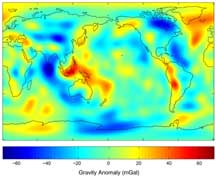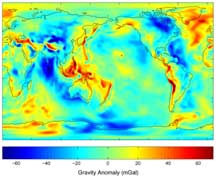
|
GRACE Gravity Model 01 - Released July 21, 2003
The GRACE Gravity Model 01 (GGM01) was released on July 21, 2003. This model was based upon a preliminary analysis of 111 days of in-flight data gathered during the commissioning phase of the Gravity Recovery And Climate Experiment (GRACE) mission, which was launched on March 17, 2002. This model is between 10 to 50 times more accurate than all previous Earth gravity models at the long & medium wavelengths. The GGM01 model is being released along with the following information.
For more information, please contact the Center for Space Research at 512-471-5573 B. D. Tapley, S. Bettadpur, M. M. Watkins and Ch. Reigber, The Gravity Recovery and Climate Experiment: Mission Overview and Early Results, Geophys. Res. Lett., 31, L09607, doi:10.1029/2004GL019920, 2004. For model EIGEN-GRACE01S, visit: http://www.gfz-potsdam.de/grace/. Progress in Measuring the Earth's Gravity Field Prior to GRACE, the long-wavelength part of the Earth's gravity field from space was determined from various tracking measurements of Earth orbiting satellites. These measurements were of considerably varying vintage and quality, and of incomplete geographical coverage. Consequently the accuracy and resolution of the Earth gravity field models were limited, with most of the satellite contributions limited to wavelengths of 700 km or longer. At shorter wavelengths, the errors were too large to be useful. Only broad geophysical features of the Earth's structure could be detected. As a result, improvements to the Earth gravity models at medium & short wavelengths had to come from the use of measurements of terrestrial or marine gravity - also of varying vintage, quality and geographic coverage. In contrast, GRACE, by itself, has provided accurate gravity information with a resolution of 200 km. This improvement has been possible by the measurement, with a high accuracy flight system, of the inter-satellite range change, which is itself very sensitive to the Earth gravity field. In the resulting gravity model, GGM01S, much more detail is clearly evident in the Earth's geophysical features. Future GRACE gravity models, derived from longer data spans and with improved processing methods and models, are expected to increase the resolution and accuracy of these models even further.
A milligal is a convenient unit for describing variations in gravity over the surface of the Earth. 1 milligal (or mGal) = 0.00001 m/s2, which can be compared to the total gravity on the Earth's surface of approximately 9.8 m/s2. Thus, a milligal is about 1 millionth of the standard acceleration on the Earth's surface. Applications This new gravity field will allow solid Earth scientists to more accurately infer the Earth's internal structure at finer resolution than ever before possible from space. Ocean scientists can combine this gravity model with ocean height measurements from satellite altimeters to study global ocean circulation on a finer scale than has been previously possible. These will, in turn, enable a better understanding of the processes that drive the Earth's dynamic system (solid Earth, ocean and atmosphere), thus leading to better analysis and predictions of climate change & natural hazards (e.g., Earthquakes). |



